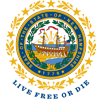Annual Federal Fiscal Risk Assessment
As a pass-through entity, the New Hampshire Department of Education (NHDOE) provides federal grant funds to eligible subrecipients, including local educational agencies (school districts and charter schools). The responsibilities of pass-through entities are given in Title 2 of the Code of Federal Regulations, Part 200.332, which requires the NHDOE to “evaluate each subrecipient’s risk of noncompliance with federal statutes, regulations, and the terms and conditions of the subaward for purposes of determining the appropriate subrecipient monitoring.”
To comply with this requirement, the NHDOE's Bureau of Federal Compliance (BFC) conducts an annual risk assessment of all subrecipients, including local educational agencies, to determine their potential risk of noncompliance. Based upon the outcome of the risk assessment, subrecipients are assigned a risk level of low, medium, or high.
The BFC updates the risk assessment model annually to ensure that risk indicators and weights reflect current risks that could lead to diversion of grant funds; loss of essential personnel; loss of accreditation; rapid growth; new activities, products, or services; and organizational restructuring.
The risk assessment criteria include indicators and weights derived from multiple sources. Each subrecipient is allotted points based upon these criteria, and assigned a risk level of high, medium, or low based on the total number of points allotted.
Purpose of the Annual Risk Assessment
The risk assessment is used to determine the likelihood that a subrecipient may fail to comply with applicable rules. If your organization is assigned a high risk level (as a result of the annual risk assessment), it does not indicate that your organization has failed to comply with applicable rules. Similarly, a low risk level does not indicate that your organization is compliant with applicable rules. Only your independent auditor or a NHDOE monitor can determine if your organization is compliant or noncompliant.
The risk assessment is conducted annually, so your organization's risk level can change from year to year. A subrecipient assigned a high risk level for 2019-2020 may be assigned a medium or low risk level in 2020–2021.
FY 25
- FY 25 Subrecipient Fiscal Risk Assessment Report for School Districts
- FY 25 Subrecipient Fiscal Risk Assessment Report for Charter Schools
FY 24
- FY 24 Subrecipient Fiscal Risk Assessment Report for School Districts
- FY 24 Subrecipient Fiscal Risk Assessment Report for Charter Schools
FY 23
- FY 23 Subrecipient Fiscal Risk Assessment Report for School Districts
- FY 23 Subrecipient Fiscal Risk Assessment Report for Charter Schools
FY 22
- FY 22 Subrecipient Fiscal Risk Assessment Report for School Districts
- FY 22 Subrecipient Fiscal Risk Assessment Report for Charter Schools
FY 21
- FY 21 Subrecipient Fiscal Risk Assessment Report for School Districts
- FY 21 Subrecipient Fiscal Risk Assessment Report for Charter Schools
Notice of NHDOE Policy
The NHDOE conducts federal fiscal grant subrecipient monitoring and compliance reviews, and implements related enforcement actions, in accordance with its established policies and procedures. These policies and procedures incorporate best practices and standards that may be similar to common auditing standards, but the NHDOE does not apply a specific set of external standards, such as the US Government Accountability Office's Generally Accepted Government Auditing Standards (Yellow Book), nor is it required to do so.




